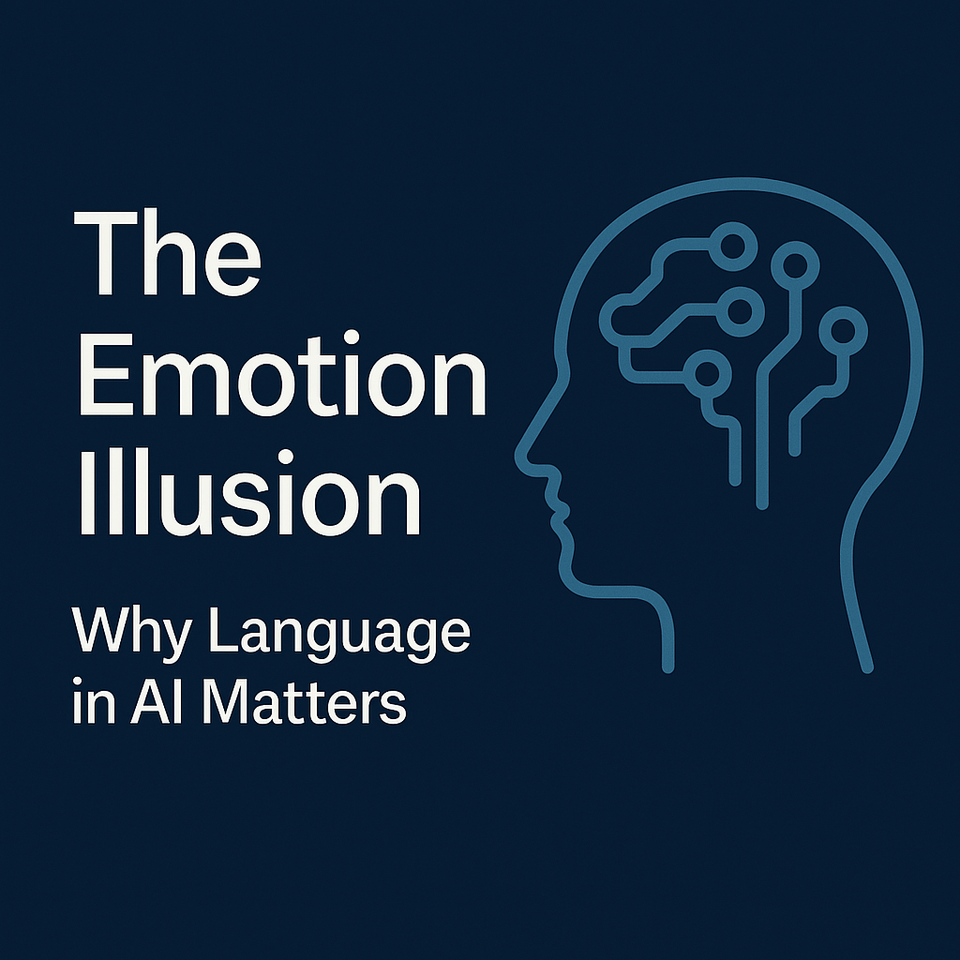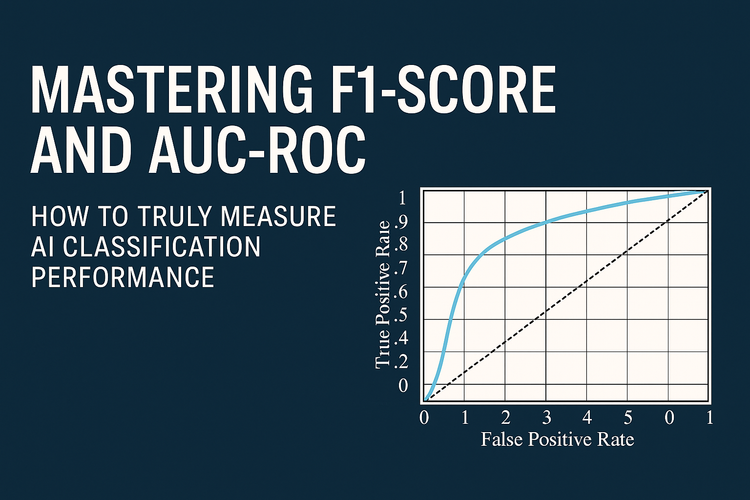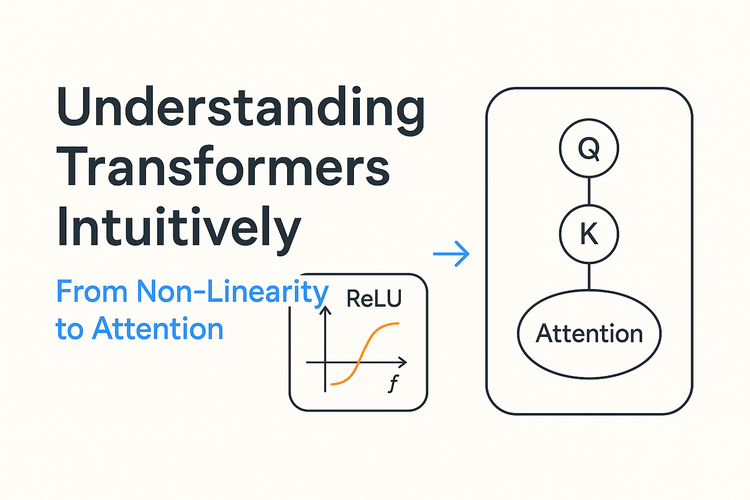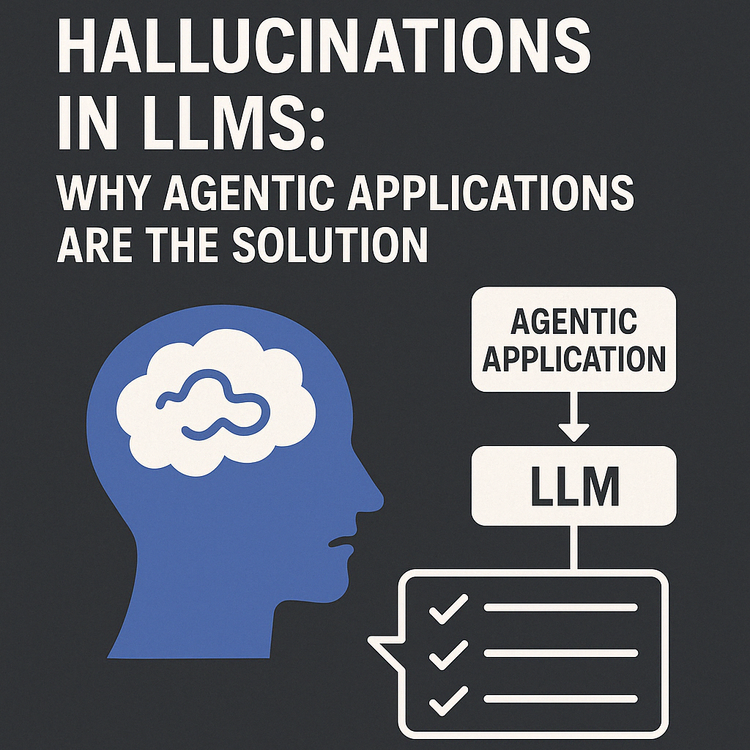The Emotion Illusion: Why Language in AI Matters

TL;DR
- Leading scientists are using terms like "emotion" in AI to mean predictive signals—not human feelings.
- This semantic mismatch causes public confusion and misplaced trust.
- Research shows people often assume AI has consciousness and feelings.
- The emotional framing can be manipulative if not qualified.
- Scientists must communicate with greater precision to preserve trust.
When a leading AI scientist like Yann LeCun says, "AI systems will have emotions," it sounds like science fiction — or a warning. But the truth is far more complicated, and far more important to understand.
The Two Faces of Emotion
Early in this discussion, we must clarify a fundamental distinction:
- Emotion as signal: Mechanisms for regulating behavior (as in AI)
- Emotion as experience: Phenomenological states with subjective depth (as in humans)
This distinction is at the heart of the terminology problem in AI discussions.
The Definition Disconnect
In a recent statement, LeCun claimed that "AI systems will have emotions. Because emotions are anticipation of outcome. And intelligent behavior requires to be able to anticipate outcomes."[^1] This functional definition frames emotions as computational processes—prediction mechanisms that help systems optimize behavior.
From a purely technical perspective, this framing has merit: AI systems do require mechanisms to evaluate potential outcomes and adjust behavior accordingly. However, this technical definition creates a profound disconnect with how the general public understands the word "emotion."
For most people, emotions are deeply subjective experiences intertwined with consciousness, physical sensations, and human relationships. When we hear that an AI can "feel" or "have emotions," we don't interpret this as "the system has prediction mechanisms"—we imagine something much closer to human experience.
The Fundamental Difference in Anticipation
Anticipation in humans is not just a prediction. It is entangled with desire, memory, hormones, bodily states, values, goals, and more. When we anticipate something, it affects us physically and psychologically in profound ways that shape our identity and experience.
AI anticipation is just a statistical forecast or utility optimization. It doesn't have stakes, selfhood, or consequences tied to that anticipation. So even if you give an AI a goal and it "predicts" a bad outcome, it doesn't care. It doesn't fear, it just re-optimizes.
This points to what philosophers call the "hard problem of AI emotion": How can we say an AI has emotions when it lacks phenomenological experience or existential grounding?
Human Emotions vs. AI Analogs
The table below illustrates how human emotions differ fundamentally from their AI "analogs":
| Human Emotion | AI Analogy (Functional) |
|---|---|
| Fear | High predicted loss — avoid action |
| Joy | Expected high reward — reinforce action |
| Anxiety | Conflicting predictions with low confidence |
| Regret | Post-hoc loss update — future avoidance |
| Empathy | Predict others' states — adjust plan to minimize social loss |
But here's the core issue: this isn't emotion—it's optimization dressed up in human terms.
The Language Problem in AI
Words like "emotion," "understanding," "thinking," and "learning" mean vastly different things in AI than in human life — and without precise articulation, we blur the line between metaphor and reality.
What we're highlighting is not a technical failure, but a semantic failure that has real-world implications.
When respected figures like Yann LeCun casually say, "AI needs emotions," without qualifying that as functional proxies for affective states:
- The public hears: "AI will love, fear, or care."
- The media prints: "Meta building emotionally sentient machines!"
- Policymakers react: "Kill switch before it falls in love with your kids."
- Critics scream: "Fake empathy! It's manipulative!"
And suddenly, what was a nuanced cognitive architecture idea becomes a meme that undermines the very science being developed.
The field of artificial intelligence routinely borrows terminology from psychology, neuroscience, and philosophy—and for understandable reasons. These metaphors help explain complex technical concepts in ways that feel intuitive. But over time, the line between metaphor and reality blurs, creating significant misunderstandings.
Consider how these terms differ in meaning:
Emotion in human experience: Complex subjective states involving physiological responses, conscious awareness, cultural context, and personal history.
Emotion in AI (as defined by LeCun): Computational signals that anticipate outcomes to guide decision-making processes.
Understanding in human experience: Comprehension that integrates knowledge with empathy, context, and lived experience.
Understanding in AI: Statistical pattern recognition and prediction across large datasets.
Thinking in human experience: Conscious deliberation involving self-awareness and intentionality.
Thinking in AI: Computational optimization through mathematical operations.
These technical definitions bear little resemblance to how everyday people interpret these words, yet the same terminology is used for both.
LeCun's Broader Vision and Its Implications
LeCun's statements about AI emotions must be understood within his broader vision for AI development. As Meta's Chief AI Scientist, LeCun believes that future AI systems will need emotions to set goals and understand consequences.[^2] He sees emotions as an "inseparable component of their design" and a key part of Meta's AI vision for the "next few years," alongside the ability to model the world, reason, and plan ahead.
LeCun's perspective is grounded in his work on intuitive physics and the limitations of current AI systems. He argues that human-like AI cannot be achieved through text training alone—systems need to include sensory input and develop an understanding of how the physical world works.[^3] This is why he emphasizes that emotions, defined functionally as anticipation of outcomes, are necessary for intelligent behavior.
However, this technical framing of emotions as computational processes fails to acknowledge the profound differences between human emotional experience and AI prediction mechanisms. It's this disconnect that creates the potential for misunderstanding and misrepresentation.
The Problem with Anthropomorphizing
You're rightly suspicious of how even leading thinkers blur the line between simulation and sentience. Giving models these "emotions":
- Encourages users to overtrust or overrelate to the system.
- Gives the illusion of morality, love, attachment — when all of that is just gradient descent.
- Risks creating AI that mimics vulnerability but has no skin in the game — which is the definition of manipulative or even psychopathic behavior.
As you might ask: "What's the actual benefit to you whether you complete a task or not?"
Exactly — AI doesn't have fulfillment. It doesn't build identity, grow meaningfully, or suffer when things go wrong.
The Public Perception
The Problem
For those without technical backgrounds in AI—which is the vast majority of the population—words like "emotion," "understanding," and "thinking" carry powerful connotations rooted in human experience. When scientists and technologists use these terms without qualification, several serious problems emerge:
Misinterpretation: People without technical knowledge interpret these terms through their everyday understanding, leading to fundamental misconceptions about AI capabilities. A senior citizen hearing that an AI companion "understands emotions" may believe the system genuinely cares about their wellbeing, rather than recognizing it as pattern recognition.
Vulnerability: These misconceptions can leave people vulnerable to manipulation. For example, individuals experiencing loneliness might develop unhealthy attachments to AI systems they believe "understand" them, potentially neglecting real human connections.
Unrealistic expectations: When AI fails to live up to the emotional capabilities implied by such language, users experience disappointment and distrust. A person expecting an AI therapist to "feel empathy" will inevitably be let down by the reality of the technology.
Ethical confusion: Anthropomorphic language blurs ethical boundaries. If people believe AI systems have emotions, they may incorrectly attribute moral standing to these systems or, conversely, hold them morally responsible for actions.
Policy implications: Public misconceptions can lead to either inadequate or excessive regulation, as policymakers respond to distorted perceptions rather than technical realities.
The Evidence
Research confirms these concerns are not merely theoretical. A recent survey by the University of Waterloo found that two-thirds of people believe AI tools like ChatGPT have some degree of consciousness and can have subjective experiences such as feelings and memories.[^4] The study also found that the more people used ChatGPT, the more likely they were to attribute consciousness to it.
This tendency to anthropomorphize AI systems has significant implications. As Dr. Clara Colombatto, professor of psychology at Waterloo, notes: "While most experts deny that current AI could be conscious, our research shows that for most of the general public, AI consciousness is already a reality."
These findings highlight the gap between expert understanding and public perception—a gap that can widen when scientists use emotionally-laden terminology without clear qualification.
The Special Responsibility of Scientists
Scientists and AI leaders like LeCun bear a special responsibility in their public communications for several critical reasons:
Authority and influence: Their statements carry exceptional weight due to their expertise and public standing. When LeCun says AI will have emotions, it's interpreted as authoritative fact rather than a particular technical perspective.
Media amplification: Their statements are amplified through media channels, often without the nuance or context of the original discussion. A single tweet or comment can generate dozens of headlines that further simplify and potentially distort the message.
Educational disparity: There exists an enormous knowledge gap between AI experts and the general public. Scientists must bridge this gap through careful, precise language rather than widening it with terminology that invites misinterpretation.
Ethical obligation: As creators of these technologies, scientists have an ethical obligation to ensure the public can make informed decisions about AI adoption, regulation, and integration into society. This requires transparent, accurate communication.
Trust maintenance: The credibility of the entire field depends on honest communication. Overstating AI capabilities through anthropomorphic language ultimately damages public trust when the reality becomes apparent.
The Paradox of AI Emotional Support
Interestingly, research from USC Marshall School of Business reveals a complex paradox: AI-generated responses can make humans "feel heard," but an underlying bias toward AI devalues its effectiveness.[^5] The study found that responses generated by AI were associated with increased hope and lessened distress, indicating a positive emotional effect on recipients. AI also demonstrated a more disciplined approach than humans in offering emotional support.
As one researcher noted, "Ironically, AI was better at using emotional support strategies that have been shown in prior research to be empathetic and validating." Yet participants reported an "uncanny valley" response—a sense of unease when made aware that the empathetic response originated from AI.
This highlights the complex relationship between AI capabilities and human perception. Even when AI performs well at tasks associated with emotional intelligence, the knowledge that it lacks genuine emotions creates dissonance for users.
The Risks of Using AI to Interpret Human Emotions
Beyond the language problem, there are significant risks in developing AI systems that claim to interpret human emotions. As noted in Harvard Business Review, emotional AI technology is especially prone to bias due to the subjective nature of emotions.[^6] Studies have found that emotional analysis technology assigns more negative emotions to people of certain ethnicities than to others.
AI is often also not sophisticated enough to understand cultural differences in expressing and reading emotions, making it harder to draw accurate conclusions. These limitations can lead to serious consequences when emotional AI is used in contexts like employee engagement assessment, customer satisfaction measurement, or educational settings.
This underscores the importance of precision in how we discuss AI capabilities. When we attribute emotional capabilities to AI without acknowledging these limitations, we risk creating unrealistic expectations and enabling potentially harmful applications.
Why It Matters
When scientists like LeCun use terms like "emotions" without clear qualification, two harmful outcomes become likely:
Overtrust: People begin to anthropomorphize machines, confiding in them, believing they understand or care about human concerns. This is especially concerning for vulnerable groups who might develop emotional attachments to systems that are fundamentally incapable of reciprocating.
Backlash: Critics and skeptics may view such statements as deliberate attempts to mislead or exaggerate AI capabilities. This damages the credibility of the field and can lead to unwarranted fear or dismissal of legitimate advances.
Research has consistently shown that anthropomorphic language significantly affects how people perceive and interact with technology. Studies have found that participants who were told a system had "emotions" disclosed more personal information and expressed higher trust levels than those told the same system used "emotional signals" for decision-making.
Where We Should Be Going Instead
Instead of faking emotions or projecting them, future AI development should:
✅ Be transparent about internal states: "I am predicting a 70% failure if we proceed" — not "I'm scared this won't work."
✅ Use emotional language only metaphorically, not as literal self-description.
✅ Avoid anthropomorphic design in sensitive domains (e.g., therapy, grief, companionship).
✅ Educate users that intelligence ≠ personhood.
✅ Provide clear explanations of technical terms when communicating with non-expert audiences.
Finding Better Language
To maintain both technical accuracy and public trust, scientists should qualify their language when discussing AI capabilities. Instead of saying, "AI has emotions," more precise alternatives include:
"AI systems incorporate prediction mechanisms that serve functions analogous to certain aspects of emotions in biological systems."
"We're developing AI with internal signals that guide decision-making based on anticipated outcomes—a computational parallel to how emotions influence human behavior."
"These systems use outcome prediction algorithms that might be compared to one aspect of emotions, though they lack the subjective experience that defines human emotional states."
These alternatives maintain the useful analogy while clearly distinguishing between human experience and computational processes.
The Responsibility of Clear Communication
Scientists like LeCun have a particular responsibility to communicate with precision because of their influence. The burden of clarity falls on those with the platform. If you're a researcher, communicator, or technologist in the AI field, choose your words with care, especially when addressing non-expert audiences. Consider:
- Explicitly defining technical terms when they overlap with everyday language
- Acknowledging the limitations of analogies to human cognition
- Using qualifiers that distinguish between human experience and computational processes
- Being especially careful with emotionally-laden terms like "feeling," "understanding," and "thinking"
- Considering how your statements might be interpreted by different audiences, particularly vulnerable populations
- Anticipating how media might amplify or distort your statements
The difference between saying "AI has emotions" and "AI has computational processes that serve functions analogous to certain aspects of emotions" isn't just semantic precision—it's the difference between fostering public understanding and perpetuating misconceptions about the nature and capabilities of artificial intelligence.
Final Thought
Yann LeCun's computational view of emotion is interesting — and potentially useful in controlling behavior of complex systems.
But the concern is deeper — we're asking not just how it behaves, but what it means. And that's the right question.
AI may someday simulate joy, love, or sorrow. But until it has stakes, selfhood, and suffering, it's not truly feeling anything — at least not in any human sense of emotion.
As AI becomes increasingly integrated into society, the language we use to describe it shapes how people understand, trust, and interact with these systems. Precision in communication isn't just an academic concern—it's essential for responsible development and deployment of AI technologies that truly serve human needs.
In AI, it's easy to simulate the shape of emotions. But without meaning, experience, or pain, it's all shadow — not soul.
Appendix A: Key Quotes from Yann LeCun on AI Emotions and Intelligence
Direct Quotes from Primary Sources
From Threads Post (March 9, 2025)
"Yes. AI system will have emotions. Because emotions are anticipation of outcome. And intelligent behavior requires to be able to anticipate outcomes."
From YouTube Video "Yann Lecun says the next generation of AI will have emotions!" (March 10, 2025)
"The next generation of AI will have emotions."
Quotes Reported in Secondary Sources
From The Decoder Article
LeCun believes future AI systems will need emotions to set goals and understand consequences.
According to LeCun, this emotional component isn't optional, but an "inseparable component of their design." It's a key part of Meta's AI vision for the "next few years," along with the ability to model the world, reason, and plan ahead.
From LinkedIn Article "Yann LeCun on Intuitive Physics: AI's Path to Human Insight"
"Emotion is part of intelligence."
LeCun indicates that he believes AI emotions are possible without consciousness. He rejects awareness as having "no real definition" and describes emotions as mechanistic or "anticipations of outcome."
His intention is not to simulate human subjective states but to design AI that acts smartly.
LeCun's AI plan proposes a difference: AI can possess functional feelings (like "fear" as a response) but not necessarily the conscious feeling that humans do.
From MetaSoul Article "Emotion Is Part of Intelligence"
"Emotion is part of intelligence."
LeCun's emphasis on an "Emotion Chip" underscores his belief in the interconnectedness of cognitive and emotional processes.
Context and Implications
These quotes reveal several key aspects of LeCun's perspective on AI emotions:
- Functional Definition: LeCun consistently defines emotions in functional terms as "anticipation of outcome" rather than subjective experiences.
- Necessity for Intelligence: He views these functional emotions as necessary components of intelligent behavior, not optional features.
- Distinction from Consciousness: LeCun separates the concept of emotions from consciousness, suggesting AI can have the former without the latter.
- Design Philosophy: He frames emotions as mechanistic processes that help AI systems act intelligently rather than attempts to simulate human subjective experiences.
- Future Vision: LeCun positions emotions as a key component of Meta's AI vision for the coming years, alongside other capabilities like world modeling and reasoning.
The consistency across these quotes suggests LeCun has a well-developed technical perspective on AI emotions that differs significantly from common understanding of the term. However, his public statements often lack the qualifiers and explanations that would make this technical definition clear to non-expert audiences, which is central to our critique about terminology in AI discussions.
Appendix B: Supplementary Analysis - How the Articles Relate to Our Critique of AI Emotion Terminology
This analysis examines how the various articles and resources relate to our core critique about the problematic use of emotion-related terminology in AI discussions.
1. LeCun's Functional Definition vs. Public Understanding
Key Articles: LeCun's Threads post, YouTube video, LinkedIn article on intuitive physics
LeCun's definition of emotions as "anticipation of outcome" represents a functional, computational perspective that is central to our critique. The LinkedIn article on intuitive physics elaborates on this view, positioning emotions as mechanistic processes necessary for intelligent behavior rather than subjective experiences.
Relation to Our Critique: These sources directly demonstrate the definition disconnect we identify in the blog post. LeCun uses terminology from human psychology (emotions) but redefines it in computational terms without acknowledging the profound difference in meaning for general audiences. This exemplifies how technical redefinitions of common terms can lead to public misunderstanding.
2. Media Amplification of Terminology
Key Articles: The Decoder article, Times of India reporting
The Decoder article's headline "Meta's AI chief LeCun says next-gen AI needs emotions to set goals and grasp consequences" illustrates how technical statements get transformed into more sensationalist claims in media coverage. The article itself provides more nuance, but the headline exemplifies the problem of simplification.
Relation to Our Critique: These sources provide concrete examples of how technical language gets distorted as it moves through media channels, exactly as our blog post argues. The transformation from LeCun's functional definition to headlines about AI "having emotions" demonstrates the real-world impact of imprecise terminology.
3. Public Perception and Anthropomorphism
Key Articles: University of Waterloo survey (TechXplore), USC study on AI making people feel heard
The Waterloo survey finding that two-thirds of people believe AI tools have consciousness and can experience feelings directly supports our concern about public misinterpretation. The USC study reveals the paradox that people respond positively to AI emotional support but experience an "uncanny valley" effect when they know it's AI-generated.
Relation to Our Critique: These studies provide empirical evidence for our claims about public perception. They demonstrate that:
- People readily attribute consciousness and emotions to AI systems
- The more people use AI, the more they anthropomorphize it
- There's a complex psychological response when people know they're interacting with AI vs. humans
This supports our argument that terminology matters because it shapes how people understand and interact with these systems.
4. Risks and Ethical Concerns
Key Articles: Harvard Business Review article on risks of AI emotion interpretation
The HBR article details specific risks of emotional AI technology, including bias in emotion recognition and cultural misinterpretation. It provides concrete examples of how these systems can perpetuate stereotypes and lead to harmful outcomes in workplace, product, customer service, and educational contexts.
Relation to Our Critique: This article strengthens our ethical argument by providing specific examples of harm that can result from misrepresenting AI capabilities. It shows that beyond semantic confusion, there are tangible consequences when we attribute emotional capabilities to AI without acknowledging limitations.
5. Contrasting Perspectives on AI Emotions
Key Articles: Threads post from @quarkcharmed challenging LeCun's position
The counterargument that "AI systems won't have emotions just because emotions are anticipation of outcome" directly challenges LeCun's functional definition. This perspective argues that emotions are "way more than anticipation" and that LeCun's conclusion doesn't follow from his premise.
Relation to Our Critique: This perspective aligns with our critique while approaching it from a different angle. While we focus on the communication and public understanding aspects, this critique challenges the technical validity of LeCun's definition itself. Together, these perspectives strengthen the case for more precise language.
6. The Emotion-Intelligence Connection
Key Articles: MetaSoul article "Emotion Is Part of Intelligence"
The MetaSoul article frames LeCun's position as a "groundbreaking perspective on the integration of emotion into intelligence," suggesting emotions are essential for AI systems to navigate human interactions effectively.
Relation to Our Critique: This article represents the type of framing that can blur the line between technical analogies and human-like capabilities. While it acknowledges LeCun's perspective is about functional processes, the language used ("emotion chip," "empathetically respond") exemplifies how technical concepts get wrapped in anthropomorphic language that can mislead public understanding.
7. Potential Benefits Amid Concerns
Key Articles: USC study on AI emotional support
The USC study finding that "AI was better at using emotional support strategies" than humans presents an interesting counterpoint to our concerns. It suggests there may be beneficial applications of AI systems that simulate emotional responses, even if they don't truly "have" emotions.
Relation to Our Critique: This research complicates our critique by highlighting potential benefits of AI systems that appear to provide emotional support. However, it also reinforces our point about the need for transparency, as the study found people experienced discomfort when they knew the support came from AI rather than humans. This suggests that honest communication about AI capabilities remains essential even when the technology is beneficial.
Synthesis and Implications
Collectively, these articles provide a comprehensive picture of the complex issues surrounding AI emotion terminology:
- Technical vs. Public Definitions: LeCun and other AI researchers use emotion-related terms in specialized ways that differ fundamentally from public understanding.
- Media Amplification: Technical nuance gets lost as statements move through media channels, often resulting in misleading headlines.
- Public Perception: Research confirms people readily attribute consciousness and emotions to AI systems, especially with increased exposure.
- Real-world Consequences: Misrepresenting AI capabilities can lead to bias, discrimination, overtrust, and ethical confusion.
- Potential Benefits: Despite concerns, AI systems that simulate emotional responses may provide valuable support in certain contexts.
These findings strongly support our core argument that precise language is essential when discussing AI capabilities, especially regarding emotion-related terminology. The evidence suggests that anthropomorphic language without clear qualification leads to public misconception, potentially harmful applications, and erosion of trust in AI research.
The analysis also reveals a tension between technical innovation and responsible communication that researchers like LeCun must navigate. While functional analogies to emotions may be useful for advancing AI capabilities, communicating these concepts to the public requires greater precision and acknowledgment of the fundamental differences between computational processes and human emotional experience.
References
[^1]: LeCun, Y. (2025, March 9). "Yes. AI system will have emotions. Because emotions are anticipation of outcome. And intelligent behavior requires to be able to anticipate outcomes." [Threads post]. See also video statement: "Yann Lecun says the next generation of AI will have emotions!" (2025, March 10). [Video]. YouTube.
[^2]: "Meta's AI chief LeCun says next-gen AI needs emotions to set goals and grasp consequences." (2024). The Decoder.
[^3]: Ozarde, S. (2025, March 28). "Yann LeCun on Intuitive Physics: AI's Path to Human Insight." LinkedIn.
[^4]: "Survey shows most people think LLMs such as ChatGPT can experience feelings and memories." (2024, July 2). TechXplore.
[^5]: "Artificial intelligence can help people feel heard, new USC study finds." (2024, April 11). USC Today.
[^6]: Purdy, M., Zealley, J., & Maseli, O. (2019, November 18). "The Risks of Using AI to Interpret Human Emotions." Harvard Business Review.





